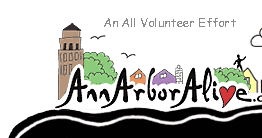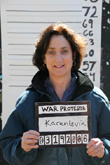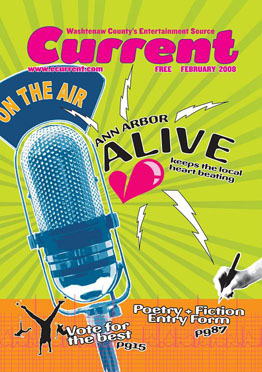 |  |
A2A Home | About Us | Forums Radio | The Neighborhood |
 |
Ann Arbor Alive keeps the local heart beating
It is not easy to sum up the mission of Ann Arbor Alive in a word, but the word Griff always comes back to is “community.” “A small town is a community,” he says, sitting at his desk a couple of days before the Jill Jack show. “Big cities have a lot of media and other outlets that can sustain a communal identity. But when you’re a small city like Ann Arbor, you’ve got to find creative ways to bind the community together.” Griff is convinced that an organization like A3, with its ability to stay low-cost and nimble, can “fill the cultural vacuum.” A3 aspires to be the preeminent cultural hub in the area, with culture loosely defined as anything that makes Ann Arbor distinctive, from music to politics to the small businesses that can’t be found anywhere else. The web experience, when fully developed, would be deeply interactive, built by the community it serves. In Griff’s ideal scenario, A3 would be a local medium for public communication as ubiquitous as cell phones and as influential as television. It would also be an advertisement to the world, serving notice that Ann Arbor is a place of cultural significance well beyond its role as home to the University of Michigan. Griff is nothing if not ambitious. Looking at the Web 2.0 explosion of the past 18 months, Griff thinks the time is ripe for A3 to kick into high gear as a local resource, although it may be more accurate to see A3 as a step towards Web 3.0, where the virtual world merges seamlessly with real everyday life. “I’ve always said when it gets into people’s cars, that’ll really be it,” Griff says, noting that with the iPhone, the technology has finally arrived to take the Internet literally anywhere. One factor in A3’s favor is the unfortunate disappearance of local content from terrestrial radio. Longtime A3 volunteer Nearly Normal Warren observes that with the recent firing of Lucy Ann Lance from WAAM and the profusion of syndicated shows on public radio, no traditional broadcast outlets remain for local news and information of any depth. This leaves an opening for a new kind of public radio with more variety, a lower threshold for participation, and a global reach: in 2007, the A3 radio website was hit for about 20,000 podcast downloads to people living as far away as Moscow. Radio is and always has been just a part of the A3 charter. Griff pulls out a sketch he drew on a piece of notebook paper years ago that documents his original vision for the group. In the center of the page is the beating heart of Ann Arbor. Radiating outward in all directions are cultural markers by which a community defines itself: music, the arts, government, business, theatre, radio, photos, books, health, nightlife, people. (The website’s “Neighborhood” page is in part an effort to make Griff’s drawing come to life.) Some who saw the drawing early on recommended that Griff focus on radio, “because that’s where the money is.” A3’s radio programming is still the most concrete and fully developed realization of the organization’s goals: local in emphasis, responsive to community needs, and rich with content. But were he to do it again, Griff says, he might not start with radio. “I would narrow the focus, go deeper into one thing,” perhaps something like the Community News Wiki, where literally anyone will soon be able to contribute local news and analysis. Other projects in the docket include the Open Government Initiative (an effort to make audio of all city government meetings available online), an Artist Day Job Directory (to help Ann Arborites support the arts by hiring artists), and the Townie Mall (where shoppers from anywhere in the world could request items and be directed to the local businesses that carry them). “We have so many good ideas,” Saunders says, “and we want to do them all.” The more ideas the group tries to tackle, of course, the harder it is for any one to come to fruition. Partly for this reason, A3 recently asked several local community leaders to form a board of directors it the hope that they will, in Nearly Normal Warren’s words, help the organization “become a little more mature.” Board member Sandi Smith sees the A3 vision as an invaluable one, but “we need to bring some focus,” and “we need to do some fundraising.” Indeed, A3 is hurting for the two things that bedevil most non-profits: people and money. To raise more of the latter—most of which has thus far come from corporate sponsors, a few generous individuals, and Griff himself—A3 is currently in the midst of a fund drive in which they hope to register 1,000 new members at $35 for a year’s membership or $120 for lifetime membership. Members receive a newsletter and announcements about new content, but when asked what membership means, Griff says with a smile, “It means you’re supporting us.” The need for more people, in Saunders’ view, is even more urgent. A3 is staffed by volunteers, and there is more to do than anyone can fathom. “Everyone here is working forty hours a week at their real jobs,” Saunders notes, “then they come here and work another forty hours.” Griff gets more specific: A3 needs people to manage the news wiki, attend government meetings, create, collect and organize content. It needs fundraisers. It needs clubs, bloggers, and other locals to post on the site. It also needs a volunteer who has the time and skills to organize and train the other volunteers. “We’re at the point now where we need Ann Arbor to tell us: do you believe this is a good thing?” Griff says. At the Jill Jack show, any doubt on that score can be laid to rest; an organization that can pull off such a high-quality event and broadcast it to the world is unquestionably a good thing. But in order to thrive, A3 needs to become more than just a good thing; it needs to become something Ann Arborites are unwilling to do without, like the Farmer’s Market or the People’s Food Co-op. To help build and maintain Ann Arbor’s identity as a community, A3 must itself become part of the local zeitgeist. It’s a tall order, but Griff has great people, a strong vision, and a whole lot of technology on his side. With a lot more money and a little focus, 2008 could be A3’s year. |
||||||||||||
| | ||||||||||||
| A3 Home | About Us | Forums Copyright © 2002 AnnArborAlive.com | ||||||||||||

Sponsor of the day
Ten Thousand
Villages
more...

Voted Best Massage in Ann Arbor
Open 7 Days a Week
Walk-in and Appointment
(734) 623-1951

Ann Arbor's premiere
window treatment &
floor covering store
5863 Jackson Rd.
(734) 663-7011

176 war protesters had their mugshots taken at Michigan Peaceworks'
"turn yourself in to the FBI and NSA" booth at
our "Stop the War"
demonstration.




